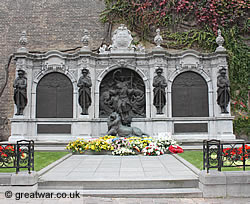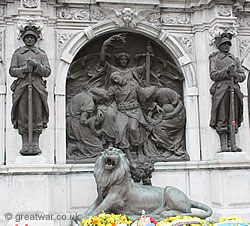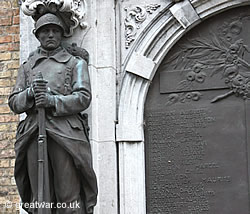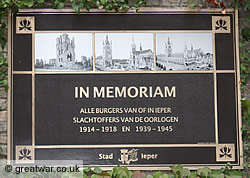Ieper War Victims Monument
The Ieper War Victims Monument is dedicated to 155 named civilian and military victims from Ieper/Ypres who died as a result of the 1914-1918 war. There are also 21 names on two plaques dedicated to the later victims who died during the Second World War when Ypres was occupied by German Forces from 1940-1945.
Design of the Monument

|
The Ieper War Victims Monument was designed by Jules Homère Martin Coomans (1871-1937). He was the Ypres town architect before the war and had been involved in a program of restoration of some of the buildings in the town when the war interrupted the work on the Cloth Hall in 1914.
Coomans was responsible for much of the post-war reconstruction of the town in the traditional historical style. Jules Coomans designed the Civil Victims monument in 1924 and it was created between 1924 and 1926 by the sculptor from Ghent Aloïs De Beule (1861-1935).
Monument Location

|
Originally Coomans intended the monument to the war victims to be located in the eastern wing of the Cloth Hall, the Nieuwerk, when it was rebuilt. He was planning to place the memorial under a covered colonade walkway. He had suggested there could be other memorials and plaques placed there too.
As it happened the money to build the eastern wing of the reconstructed Nieuwerk was not available in 1926 when the monument was complete and instead it was positioned on a piece of ground at the western end of the Cloth Hall, at the far eastern end of Boterstraat. Here some original houses, destroyed in the war, were not rebuilt. The monument was located at the junction of Boterstraat and the street called at that time the Hallestraat after 1918 (previously called Aalstraat).
In 1938 the Hallestraat street was renamed Jules Coomansstraat in memory of Jules Coomans who had died in 1937.
Unveiling of the Monument

|
The monument was unveiled in a ceremony on Sunday 27 June 1926.
“The Ieper Fury”
The monument is known by the local people as “The Ieper Fury”. This name comes from the fact that there was a riot on the day of the unveiling involving the State Police and members of the Flemish Veterans Association, a Flemish Nationalist pressure group. The Flemish Veterans Association (FVA) was very unhappy that they were placed at the back of the procession marching to the memorial for the unveiling ceremony. Added to this, they were upset that the official flags hanging on the Town Hall for this special event, at that time located in the reconstructed building of the “Hotel de la Chatellenie” or “Kasselrij” on the north side of the Grote Markt (market square), did not include the Flemish national flag.
The procession was formed up in the Boterstraat and before it marched off a fight broke out. The state police on horseback charged at the members of the FVA, resulting in some people being injured. During the ceremony at the memorial the FVA laid a wreath of flowers to the victims of the war and again there was trouble as the state police rushed the crowd, even drawing their swords. There were more injuries to the people in the crowd and members of the FVA and some people were also arrested by the police. It was the Flemish press who covered the story and who coined the phrase “The Ieper Fury” as they described the events that had happened.
Ypres Civilian Victims Plaque

|
In 2010 a new plaque was put up on the wall of the Ypres War Victims monument and dedicated to the civilian casualties of Ypres in the First and Second World Wars. The text on the plaque reads:
“IN MEMORIAM. ALLE BURGERS VAN OF IN IEPER SLACHTOFFERS VAN DE OORLOOGEN 1914-1918 EN 1939-1945.”
Location of the Ypres War Victims Monument
The monument is located on Jules Coomansstraat opposite the westernmost end of the Cloth Hall (Lakenhalle) in the centre of Ieper (Ypres).
Related Reading
The Reconstruction of Ypres by Dominiek Dendooven and Jan Dewilde (revised and reprinted) is a fascinating book about the regeneration of the city of Ypres/Ieper after 1918. It is available to buy in person or by mail order from the In Flanders Fields Museum shop in Ypres/Ieper. Go to the link below to place an order:
Website: www.inflandersfields.be Museum shop 'On Request'
Acknowledgements
The Reconstruction of Ypres by Dominiek Dendooven and Jan Dewilde.
